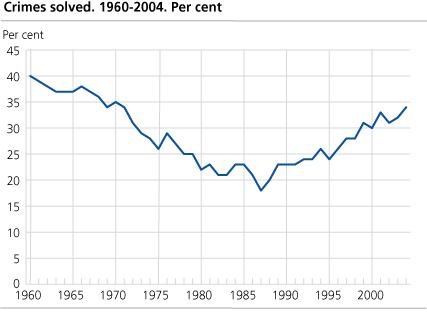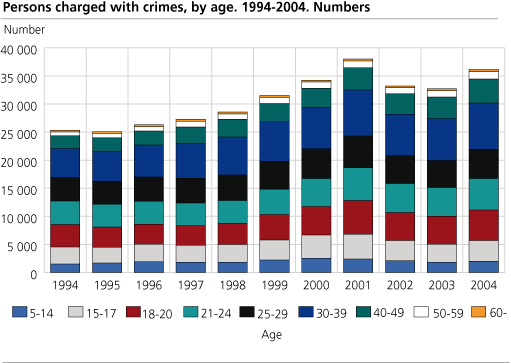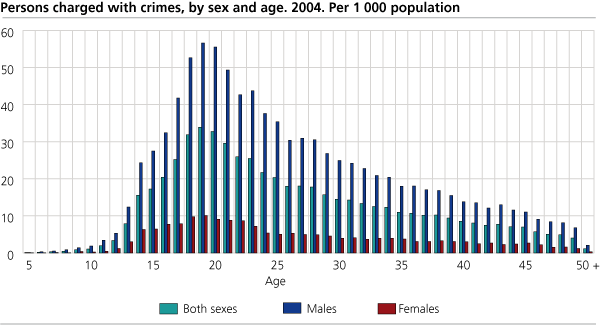Content
Published:
This is an archived release.
Higher clear-up rate and more persons charged
413 000 offences were investigated in 2004. Compared with 2003, there was a 4.2 per cent increase in misdemeanours investigated and a 2.2 per cent decline in crimes investigated. The percentage of solved offences and the number of persons charged increased and were, except persons charged in 2001, higher than in the ten previous years.
Taking the population into account, the number of completely investigated offences has not been lower since 1997. Compared to the previous year, there was a 3.4 per cent decline in crimes for profit and narcotic crimes and a 3 per cent decline in crimes inflicting damage to property. On the other hand, violent and sexual crimes increased by 7.3 and 13 per cent respectively (see table). The decline in the number of aggravated larceny and theft of motor vehicles contributes to the figures for theft crimes being at their lowest level since 1994.
There was an increase in the number of misdemeanours against all the specified acts in the crime statistics, but in absolute figures the increase was largest misdemeanours against the Road Traffic Act (from 58 500 to 61 500).
| Offences investigated, by group of crime. 1995-2004 |
| 1995 | 1996 | 1997 | 1998 | 1999 | 2000 | 2001 | 2002 | 2003 | 2004 | ||||||||||||||||||||||||||||||
|---|---|---|---|---|---|---|---|---|---|---|---|---|---|---|---|---|---|---|---|---|---|---|---|---|---|---|---|---|---|---|---|---|---|---|---|---|---|---|---|
| Offences, total | 366 565 | 379 053 | 379 905 | 402 095 | 419 009 | 425 326 | 426 053 | 402 044 | 414 912 | 413 206 | |||||||||||||||||||||||||||||
| Crime, total | 269 282 | 275 421 | 272 653 | 292 258 | 307 063 | 314 027 | 310 447 | 298 500 | 301 699 | 295 192 | |||||||||||||||||||||||||||||
| Economic crime | 5 426 | 5 294 | 5 954 | 6 311 | 7 357 | 6 536 | 7 065 | 6 284 | 6 454 | 6 663 | |||||||||||||||||||||||||||||
| Other crimes for profit | 202 104 | 200 008 | 193 282 | 205 908 | 210 813 | 212 542 | 201 746 | 196 679 | 199 053 | 192 372 | |||||||||||||||||||||||||||||
| Crime of violence | 16 735 | 17 246 | 17 834 | 18 819 | 19 776 | 21 979 | 23 403 | 22 179 | 23 348 | 25 058 | |||||||||||||||||||||||||||||
| Sexual crime | 2 026 | 2 593 | 3 921 | 2 828 | 2 824 | 2 689 | 2 498 | 2 422 | 2 792 | 3 156 | |||||||||||||||||||||||||||||
| Crime of narcotics | 15 736 | 20 930 | 24 147 | 30 447 | 36 334 | 38 543 | 44 029 | 41 220 | 42 561 | 41 107 | |||||||||||||||||||||||||||||
| Crime inflicting damage to property | 21 414 | 23 115 | 20 585 | 20 659 | 22 190 | 24 312 | 22 954 | 19 956 | 18 957 | 18 387 | |||||||||||||||||||||||||||||
| Other crime 1 | 5 841 | 6 235 | 6 930 | 7 286 | 7 769 | 7 426 | 8 752 | 9 760 | 8 534 | 8 449 | |||||||||||||||||||||||||||||
| 1 Including environment crimes. |
Higher clear-up rate - also for larceny
Altogether 47 per cent of the offences and 34 per cent of the 295 000 crimes, were solved. The percentage of crimes solved in total was higher (2 per cent) than in the previous year, and has not been higher since 1970 (see figure).
Larceny and other offences for profit make up a large part of all completely investigated offences (65 per cent of all crimes in 2004), and have a lower clear-up rate than most other types of offences. Thus, a decrease in the number of larceny reported to the police may result in a rise in the total percentage of offences solved. This is, however, not the explanation for the increased percentage of offences solved from 2003 to 2004, when the percentage of all crimes solved except theft also increased by 2 per cent (from 60 to 62 per cent). Both theft of motor vehicle (19 per cent), simple or minor larceny (13 per cent) and aggravated larceny (10 per cent) had a relatively high clear-up rate in 2004, and in total 13 per cent of all theft-crimes were solved, the highest level since 1994.
Among the 195 000 solved offences, 86 400 were committed for trial, and in total one fifth of all investigated offences ended in court. 27 per cent of crimes and 65 per cent of misdemeanours were either given on the spot fine or committed for trial.
More rapes, but fewer solved and committed for trial
The number of completely investigated rapes was historically high in 2004, also when considering the extended rape regulations1. The 634 rapes in 2004 are 8 per cent more than the previous year and 26 per cent more than in 1999, one year before the amendments to the Penal Code on sexual crimes were introduced. Despite the increase in number of completely investigated rapes, far less cases ended in the courts in 2003 than in the three previous years. The number of rapes committed for trial, for instance, was 30 per cent lower than in 2003. In 2004, 14 per cent of all completely investigated rapes were committed for trial, a much smaller share than in 2002 for instance, when the corresponding figure was 24 per cent.
Prosecution was dropped for 12 per cent of rapes because of insufficient information about the offender, and 69 per cent because of deficient evidence. In total, 18 per cent of rapes were solved in 2004, and the percentage of offences solved was much lower than in all the ten previous years, when it was between 24 and 28 per cent.
In 2004, 50 murder cases were closed. This is twice as many as in 2002, and only in a few years around 1990 has the legal system completed so many murder cases in one year.
More offenders
During 2004, a total of 83 800 individuals got one or more decisions with legal efficacy against themselves (excluded on the spot fines for traffic misdemeanours and misdemeanours against the Duty Act, see Sanctions). Of these, 36 100 were given one or more decisions for one or more crimes, an increase of 10.5 per cent from the previous year.
Compared to the previous year, there was an increase in all age groups, both amongst those caught for crimes and those only caught for misdemeanours. The percentage increase was largest in the youngest (under 18 years) and the oldest (50 years and over) age groups. Even with the 13 per cent increase compared to the previous year, a considerably higher number of persons below the age of 18 were caught for crimes in the years 2000-2001. 18-20 year olds are most often caught for offences, and in 2004, 3.3 per cent of all residents in this age group got a decision for crimes against themselves. Of all persons charged with crimes, 31 per cent were under the age of 21 years and 30 per cent in the age group 21-29 years (see figures). Men represented 85 per cent of all charged with crimes, and 82 per cent of all persons charged with misdemeanours.
In 2004, 8 of 1 000 persons living in Norway were charged with one or more crimes. Those living in Oslo (11.5), Vestfold (10.2), Telemark (10.0), Vest-Agder (9.4), Finnmark (9.0) and Buskerud (8.3) had higher rates than the country as a whole. The share of the population caught for an offence should, among other things, be considered in proportion to the share of solved offences in the different regions. For instance, there is a reason to believe that the share of charged Oslo residents would have been even larger if Oslo police district had the same clear-up rate as Sogn og Fjordane; i.e. more than half, and not less than one fourth of all the completely investigated crimes solved.
Nine out of ten are Norwegian
87.4 per cent of all persons charged with crimes were Norwegian citizens, and 6.8 per cent had citizenship in other European countries. The share of citizens from other European countries was about the same as the average for the two previous years (see textbox).
Many are caught several times
Of all persons charged with crimes in 1999 (with official Norwegian reference number), 60 per cent were caught for at least one offence during the next five years. The largest recidivism, with about 80 per cent, was amongst those with more serious types of theft or robbery as principle offence in 1999. Statistics for the period 1999-2004 also show a considerable larger recidivism for men (50 per cent) than for women (31 per cent). The connection between age and recidivism also differed by sex: The share of recidivism decreases considerably with growing age among men, whilst the share of recidivism among women increases up to the age group 30-39 years - where it is at the highest with 40 per cent.
Police reform and change in routines for producing the statistics on offences investigated As of 1 January 2002, a new structure for the police districts was established; where for one thing the number of police districts was halved. Statistics Norway has as result of this, and the following technical re-adjustments in the central police criminal register system (BL/STRASAK/PAL, from October 2002 included), changed the routines for producing the statistics on offences investigated. Because of changed contents for date of decision in the data basis from the central police register, the statistics for 2004 are based on a main extract from May 2006 - which is almost one and a half year later than normal. This is the reason why Statistics Norway not until now has been able to publish the surveys on the completely investigated criminal cases in 2004. After a thorough examination of the different data basis and crime statistics, in addition to dialogue with Norwegian Police Data and Procurement Service (PDMT), Statistics Norway is of the opinion that the statistics on offences investigated 2004 has become fairly comparable to previous years. The police reform, together with the changes made in Statistics Norway's own categories (see textbox), is however of some importance to comparability of the statistics over longer time. |
News on statistics on offences investigated 2002: - New police districts replace the previous geographical division. The possibilities of comparing these to statistics on police districts prior to 1 January 2002 are to a great extent restricted. - Several persons charged without registered and valid official Norwegian reference number are being identified if they have committed more than one offence. This gives a somewhat lower number of persons charged and a higher number of persons charged with more than one offence, for persons committing offences when on a temporarily residence in Norway in particular. - Statistics on the number of accessories shows to a greater extent the actual number of offenders with who the person charged has committed the offence in cooperation with. This involves a somewhat higher number of accessories than it would have been out of the previous method of surveying these. - Transfers to Conflict Council are only made available as settlement valid in law only against persons charged over the age of consent. This involves that the number of transfers to Conflict Council decreases, and that prosecutions dropped, the offender not liable, become correspondingly more. There have also been several other changes which have contributed to a quality improvement of the data basis and the statistics, something that to a greater extent will take effect in future volumes. The content in statistics on offences investigated 2005, will follow the same routines and definitions as for 2002-2004 statistics, and will be published during the next months. |
1 All numbers on rape includes previous regulations on sexual intercourse "with unconscious person" and "by threats, cunning behaviour etc." - as distinction to the tables, where they are specified as own types of offences.
Contact
-
Reid Jone Stene
E-mail: reid.jone.stene@ssb.no
tel.: (+47) 99 02 22 01
-
Siri Fjærtoft Fossanger
E-mail: siri.fossanger@ssb.no
tel.: (+47) 99 72 49 27
-
Sigmund Book Mohn
E-mail: sigmund.mohn@ssb.no
tel.: (+47) 94 32 77 22



